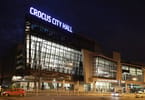Carefully observing the changing demographics of US society, Mexico’s federal government is wagering that the graying of Gringolandia will give a strong impulse to medical tourism. “A million baby boomers, as they are called in the US, could come to live in Mexico in the coming years,” said Mexican Health Minister Jose Angel Cordova Villalobos at an event held earlier this month in Mexico to mark National Nursing Day. An opportunity exists, Cordova said, for tourism promoters to sell not only sun and sand but also “treatments or surgeries.”
In coordination with other federal agencies, the Health Ministry plans to build up the medical tourism infrastructure during the next two years. Important components of the initiative include training a corps of bilingual Spanish-English nurses, and increasing the number of private Mexican hospitals accredited by a joint US-Mexico commission already at work. According to Cordova, eight such private institutions have been certified under the commission’s standards.
Although regional initiatives to promote medical tourism are underway in the northern border states of Chihuahua, Baja California and Nuevo Leon, Cordova said greater coordination at the federal level is needed to tap a global market enjoyed by nations including Thailand, India, Costa Rica and Brazil. Mexico’s leading health official stressed the new program will benefit the private sector.
“This is going to be an incentive for the private market,” Cordova said. Cordova acknowledged that training bilingual nurses risks a bigger brain drain to the US, where some localities are already recruiting Mexican nurses for much higher pay than they receive at home, but he was careful to add the envisioned training will focus on elite sectors of Mexican health care delivery like cosmetic surgery and other specialized treatments. Pilot programs to train bilingual nurses are in the stage of preparation, Cordova added.
Whether or not medical tourism booms in Mexico will depend on a variety of social, economic, political and security trends both to the north and south of the border. Continued violence in parts of the border region is likely to hamper potential growth in the short-term. A big factor will be the outcome of so-called health care reform in the US, especially if legislation is passed that increases rather than lowers costs as the Obama administration proposes.
Medical Tourism in a Tourist Town
A former head of the Puerto Vallarta Medical Association who currently serves on the municipal health committee, Dr. Jorge Roberto Cortes, or “Doctor Jorge” as he likes to be called, is skeptical that health care will be a bigger reason for people to come to Mexico than it is now.
Still, coincidental visits to the doctor or dentist are increasingly important in tourist destinations like Puerto Vallarta. For instance, Cortes estimated his patient load consists of 50 percent foreigners and 50 percent Mexican nationals. In Puerto Vallarta and elsewhere in Mexico, sick tourists from the US will discover that medical costs are far cheaper than at home. According to Cortes, office visits hover around $40, while x-rays costing as little as $40 can be turned around in less than 45 minutes.
After several years in the US that included a stint at Mt. Sinai, Cortes speaks English with barely a hint of an accent. And he is not the only local, bilingual health care provider. A city of more than 300,000 people, Puerto Vallarta has a plethora of public and private hospitals, hundreds of doctors, modern medical labs and ready medical evacuation services.
“It´s a lot, but Vallarta is growing up,” the general practitioners said. “We have all the specialties. You die if you want to. We have everything here.”
A local medical services guide distributed in Puerto Vallarta contains ten pages advertising specialists, family doctors and even psychologists. On its website, the Guadalajara-headquartered San Javier Hospital lists foreign insurance companies from which it will accept payments.
The companies include Cigna, Aetna, Tricare and International Health Insurance of Denmark, among others. The hospital advertises birth delivery for about $700 and hysterectomies for approximately $1,000. The prices include one and two night hospital stays, respectively.
Another local facility, Medasist Hospital, charges less than $30 for a short emergency room visit, between $20-$30 for urgent care, and from $90 to $120 per night for hospital rooms. Doctor’s fees are extra.
Dr. Cortes is among the physicians who prefer to deal on a cash basis. Echoing complaints familiar in the US, Cortes said bureaucratic delays and nay-saying can make private insurers troublesome. Typically, insurance companies take months to pay Mexican health care providers.
In tropical areas like Puerto Vallarta, new residents and tourists should be aware of the possibility of contracting unfamiliar illnesses like dengue. The State of Jalisco operates a spraying program to eradicate mosquitoes in Puerto Vallarta, but at least 13 people contracted the disease in January according to a state health department report cited in the press.
From Braceros to Baby Boomers
Hailing from a nurse’s family in California’s San Joaquin Valley, Pamela Thompson once treated Mexican farm workers in the emergency room. Nowadays, Thompson’s HeathCare Resources Puerto Vallarta company networks US expatriates and tourists with Mexican healthcare providers. Thompson said interest in Mexican medical care is growing among both US consumers and private insurers.
Interviewed on a busy high season day, the consultant said the recession had not significantly slowed visits from foreigners, especially gay men, seeking operations like plastic surgery. According to HealthCare Resources Puerto Vallarta’s website, several specialized surgical packages are 30-40 percent cheaper in Mexico than in the US and Canada.
Thompson said she had received recent inquiries from US-based insurance companies about sending patients to Mexico. “I think that’s going to happen soon,” Thompson said. “(Private insurers) are starting to think about it, talk about it.”
According to Thompson, four basic types of insurance are available to foreign tourists and residents in Mexico — international, travel, private Mexican, and state-run Mexican Social Security Institute (IMSS) coverage. For short-term or winter season visitors to Mexico known as “snowbirds,” travel insurance is the most practical option, Thompson asserted.
The former nurse said many US citizens are surprised to learn that private health insurance in Mexico costs as low as $1,500 per year, though a huge drawback for many is that companies will not cover anyone over 62 years of age. Fulltime residents of Mexico who hold FM-3 visas can now qualify for IMSS coverage, Thompson said, cautioning the public system is overloaded and quality far from desirable. Still, she said, IMSS insurance is “absolutely better than nothing.” For the truly destitute foreigner, regional public hospitals will accept an admission.
Given the aging of many US residents of Mexico, the inability to use Medicare to pay for health-related expenses south of the border is problematic for many expatriates and potential immigrants — at least until now. Meantime, the growing size of the US retiree population in places like Puerto Vallarta has attracted the notice of hospitals north of the border, which offer free health clinics in Mexico during the high season to court potential patients. In conjunction with hospitals, Thompson said she had facilitated transfers of US retirees from Puerto Vallarta to institutions back in the old country.
Yet increasingly, Thompson said she had been witness to another tendency: younger US citizens relocating with their families to Puerto Vallarta. The possibility of working at home via the Internet favors this trend, the longtime resident of Puerto Vallarta added. “I’ve had more calls for pediatricians here during the last 6 months,” Thompson said.
Intimately familiar with the local scene, Thompson acknowledged there were “quacks” around “just like everywhere else.” But the health care professional stood by the overall quality of doctors and services available in the Pacific port city.
“We have great physicians in the area. The doctors here spend time with you,” Thompson said. “You can call them on a cell-phone and you don’t have to go through 20 people to get an appointment. All the doctors I work with are like that.”
In Mexico, getting personal recommendations from knowledgeable locals is a good way of rooting out the frauds.
What about the Old Choppers?
Back in the US, meanwhile, the issue of dental treatment has been virtually absent from the so-called health care reform debate. But a glance at rates charged by Mexican dentists quickly reveals a continued, major attraction for both tourists and prospective immigrants.
Not far from Cortes’ office, and just off a bridge that crosses the Cuale River with its tropical denizens of darting birds and fighting iguanas, dentists Jessica Portuguez and Gloria Carrillo staff an Old Town Vallarta branch of Solu/Dent, a privately-owned business. Recently, the clinic offered two cleanings for $12 and extractions for $9 per tooth. According to Carrillo, five porcelain teeth for a bridge cost approximately $500.
After three years in business at the site, Portuguez and Carrillo estimate that 40 percent of their patients are foreigners during the tourist high season which spans the months from October to March. Local expatriates, who include customers from the nearby, old hippie settlement of Yelapa, spread Solu/Dent’s name by word-of-mouth and bring in family members and friends. “They like how we attend them here,” Carrillo contended.
A graduate of the University of Veracruz, Portuguez came to Puerto Vallarta two years ago after hearing how the large floating and resident foreign population created ample work opportunities for new dentists. According to the relocated southerner, Mexican dentists must complete five years of studies and one year of social service to obtain basic licensure. “We have very accessible prices and good quality,” Portuguez said. “We have trained doctors. We studied for this. All work is guaranteed.”
In Puerto Vallarta, “English-speaking” signs are visibly posted outside many dentists’ offices. Portuguez, who said she studies English in her spare time, assured that a bilingual receptionist was available to help the office’s dentists translate with patients. Solu/Dent recently opened a third branch in Bucerias, a community just north of Puerto Vallarta where many US-born immigrants have moved. “We hope nothing changes and we stay here,” Portuguez said.
WHAT TO TAKE AWAY FROM THIS ARTICLE:
- Cordova acknowledged that training bilingual nurses risks a bigger brain drain to the US, where some localities are already recruiting Mexican nurses for much higher pay than they receive at home, but he was careful to add the envisioned training will focus on elite sectors of Mexican health care delivery like cosmetic surgery and other specialized treatments.
- Although regional initiatives to promote medical tourism are underway in the northern border states of Chihuahua, Baja California and Nuevo Leon, Cordova said greater coordination at the federal level is needed to tap a global market enjoyed by nations including Thailand, India, Costa Rica and Brazil.
- Whether or not medical tourism booms in Mexico will depend on a variety of social, economic, political and security trends both to the north and south of the border.






















